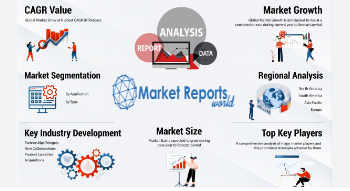Report Ocean: Mobility as a service (MaaS) market report, 2024-2032
Mobility as a Service (MaaS) Market Analysis, Service Types, Applications, and Regional Trends, 2024-2032

Press Release, Nov. 6, 2024
Report Ocean has published a new report on the Mobility as a Service (MaaS) Market, delivering an extensive analysis of key factors such as market restraints, drivers, and opportunities. The report offers a detailed examination of industry trends and developments shaping the growth of the Mobility as a Service (MaaS) market. It also provides a comprehensive analysis and forecast of the market future performance.
Global Mobility as a Service (MaaS) Market is valued at approximately USD 45.88 billion in 2023 with a compound annual growth rate (CAGR) of 5.07% during the forecast period from 2024 to 2032.
MaaS is revolutionizing the transportation industry by integrating various transport services, such as ride-sharing, public transit, and car rentals, into a unified digital platform. Through the use of mobile applications, MaaS enables seamless trip planning, booking, and payment processes via a single interface, offering users convenient, on-demand access to transportation services. The solution promotes sustainable and flexible mobility options, effectively reducing the dependency on personal vehicle ownership, which aligns with the growing demand for efficient urban transportation alternatives.
Global MaaS market growth is propelled by several factors, including rapid urbanization, rising concerns over environmental sustainability, and increasing adoption of shared mobility services. The transportation industry is witnessing a paradigm shift as consumers move away from traditional ownership models toward more shared, subscription-based alternatives. Technological advancements are playing a crucial role in this transition, enabling the integration of various mobility services into one cohesive platform. However, despite the market’s promising growth trajectory, several challenges such as regulatory complexities, significant initial investment costs, and concerns surrounding data privacy remain as barriers. Nonetheless, the market presents ample opportunities, particularly in the areas of autonomous vehicle integration, expansion into emerging markets, and fostering public-private partnerships.
Regionally, Asia-Pacific is expected to continue its dominance in the MaaS market, driven by factors such as rising vehicle ownership costs, rapid urbanization, and increasing fuel prices, particularly in major economies such as China and India. The region’s dense urban population and inadequate public transportation infrastructure further drive the demand for MaaS services. On the other hand, North America is projected to be the fastest-growing region, with rising awareness regarding environmental impacts, emissions reduction, and traffic congestion being key contributors to the region’s robust market growth. The increasing adoption of digital platforms and growing consumer awareness of the benefits of shared mobility are also aiding in the rapid expansion of MaaS in North America.
Major market players included in this report are:
Uber Technologies Inc.
Lyft, Inc.
Didi Chuxing Technology Co.
ANI Technologies Pvt. Ltd.
Grab
Shuttl
BMW Group
Moovel Group GmbH
Via Transportation Inc.
Yandex.Taxi
Car2Go
BlaBlaCar
Scoot Networks
Zipcar
Ola
The detailed segments and sub-segments of the market are explained below:
By Service Type:
Ride-Hailing
Car Sharing
Taxi Services
Others
By Application Type:
iOS
Android
Others
By Region:
North America
U.S.
Canada
Europe
UK
Germany
France
Spain
Italy
Table of Contents:
Chapter 1: Introduction to the Mobility as a Service (MaaS) Industry
Chapter 2: Executive Summary
Chapter 3: Dynamics of the Market
Chapter 4: Profiles of Leading Companies
Chapter 5: Competition in the Mobility as a Service (MaaS) Market among Players
Chapter 6: Market Size across Regions
Chapter 7: Application Segments in the Market
Chapter 8: Segment Analysis of the Mobility as a Service (MaaS) Industry
Chapter 9: Market Chain, Sourcing Strategies, and Downstream Buyers
Chapter 10: Strategies and Key Policies by Distributors/Suppliers/Traders
Chapter 11: In-depth Analysis of Key Marketing Strategies by Market Vendors
Chapter 12: Evaluation of Market Impact Factors
Chapter 13: Forecasted Mobility as a Service (MaaS) Market Size (2024-2032)
Frequently Asked Questions: –
1.What is the size and growth rate of the industry market?
2.Who are the leading companies in the market?
3.What are the primary drivers of market growth?
4.What challenges or barriers do market participants face?
5.Are there any regulatory or legal factors impacting the market?
6.What are the emerging trends or opportunities within the market?
7.How is the market segmented, and what are the characteristics of each segment?
8.What pricing trends are observed in the market?
9.What does the competitive landscape of the industry look like?
10.What are the consumer preferences or purchasing behaviors in the market?
11.Are there any regional or geographic differences in the market?
12.What are the market projections for the coming years?
About Report Ocean:
Report Ocean is a leading provider of market research, delivering high-quality insights to help clients across industries achieve their strategic goals. Their reports are designed to enhance market share in today’s competitive landscape by offering innovative and actionable market intelligence. As a trusted source of comprehensive market analysis, Report Ocean is the go-to solution for individuals, organizations, and industries seeking to stay ahead in the market.




